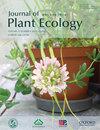Aboveground net primary productivity was not limited by phosphorus in a temperate typical steppe in Inner Mongolia
IF 3.9
2区 环境科学与生态学
Q2 ECOLOGY
引用次数: 0
Abstract
Phosphorus (P) is an essential element for plant growth, however, whether the aboveground net primary productivity (ANPP) of typical steppe was limited by P remains obscure. To detect the effects of P addition on primary productivity and aboveground biomass of different plant functional groups both under ambient and N addition conditions, ANPP and aboveground biomass of grasses and forbs were measured from 2016 to 2020 on a 16-year N and P addition experiment platform in a temperate typical steppe in Inner Mongolia. The soil available N and P concentration were also determined to test the relationship between ANPP and the availability of soil nutrient. We found that P addition under ambient condition had no significant effect on ANPP and the aboveground biomass of grasses and forbs. Whereas, under N addition, P addition significantly increased ANPP and the aboveground biomass of forbs. Furthermore, soil available N and P concentration were increased significantly by N and P addition, respectively. Moreover, there was no significant correlation between ANPP and soil available P concentration, while, ANPP was positively correlated with soil available N concentration. These results suggested that P was not the key factor limiting the primary productivity of the temperate typical steppe in Inner Mongolia. However, under N addition, P addition can promote ANPP and alter the community composition. These findings provide valuable information for the management of the temperate typical steppe.内蒙古温带典型草原地上净初级生产力不受磷的限制
磷(P)是植物生长的必需元素,但典型草原地上净初级生产力(ANPP)是否受到磷的限制尚不清楚。为了检测环境和氮添加条件下磷添加对不同植物功能群初级生产力和地上生物量的影响,在内蒙古温带典型草原16年氮磷添加实验平台上,测定了2016年至2020年牧草和杂类的ANPP和地上生物量。测定了土壤有效氮和有效磷浓度,以检验ANPP与土壤养分有效性的关系。结果表明,在环境条件下添加磷对ANPP和牧草地上生物量没有显著影响。而在施氮条件下,施磷显著提高了ANPP和地上生物量。此外,添加N和P分别显著提高了土壤有效N和P浓度。此外,ANPP与土壤有效磷浓度无显著相关性,而与土壤有效氮浓度呈正相关。这些结果表明,磷不是制约内蒙古温带典型草原初级生产力的关键因素。然而,在添加N的情况下,添加P可以促进ANPP并改变群落组成。这些发现为温带典型草原的管理提供了有价值的信息。
本文章由计算机程序翻译,如有差异,请以英文原文为准。
求助全文
约1分钟内获得全文
求助全文
来源期刊

Journal of Plant Ecology
生物-植物科学
CiteScore
4.60
自引率
18.50%
发文量
134
审稿时长
3 months
期刊介绍:
Journal of Plant Ecology (JPE) serves as an important medium for ecologists to present research findings and discuss challenging issues in the broad field of plants and their interactions with biotic and abiotic environment. The JPE will cover all aspects of plant ecology, including plant ecophysiology, population ecology, community ecology, ecosystem ecology and landscape ecology as well as conservation ecology, evolutionary ecology, and theoretical ecology.
 求助内容:
求助内容: 应助结果提醒方式:
应助结果提醒方式:


